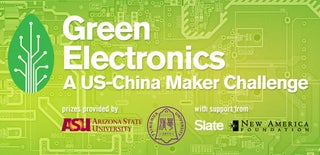Introduction: Recycling CPUs Processor Heat
This Project involves conversion of waste heat released by the processor of the computer to Electrical energy using the peltier Effect.
The electricity is generated by the peltier tiles which are placed across temperature difference between the bottom of the laptop, which is hot and the ambient air which has a moderate temperature.
Summary-
I chose to do a research on the peltier effect as I had earlier heard from people that a lot of heat is wasted which is generated by the processor. Today we are mostly using non-renewable sources of energy to generate electricity which will be depleted in the next 50 years. So I decided to recycle heat generated by the computer processor as I had studied “Law of conservation of energy” which says that energy can neither be created nor destroyed but can be converted from one form to another.
In the peltier module, when one side is heated and other is cooled, through the temperature difference it generates electricity.
I had calculated the area of bottom of the laptop and calculated the area needed to recycle energy. My project has generated about 1.2V en the first build. This voltage was enough to run a USB computer fan.
I have took 12 peltier tiles and placed them on a top of a Gel pack. On above the peltier tiles There was the bottom of laptop.
If this technology is further developed, we can save over 50%-70% of the battery life and thus save electricity.
Question / Proposal-
Hypothesis: If I can capture enough heat from the processor of computer and convert it efficiently to electricity, then I can save the battery lifetime.
Objective: To make a processor heat recycler that generates electricity using the heat generated by the processor.
Step 1: Technical Design
Now, we will see the technical design of this project.
Firstly, We need a heating source and secondly we need a cooling source. In my case, the laptop's processor is the heating source and the Gel pack is the cooling source.The electricity is generated by the peltier tiles which are placed across temperature difference between the bottom of the laptop, which is hot and the ambient air which has a moderate temperature.
When the heat is transferred from the laptop to the gel pack, electrons flow and generate electricity.
Step 2: Materials
Here is the list of materials you need for this project-
1) A Gel Pack
2) TEC Peltier Modules [TEC-12704 or TEC-12706]
3) A set of wires
4) A Laptop
5) A USB computer Fan
6) A laptop Pin [Optional]
7) A Multimeter [Optional]
Step 3: Construction of the Circuit
In this step, we will join all Peltier modules together and connect everything together.
Now place the peltier tiles on the Gel pack. Connect them using wires in series. The peltier tiles should be placed in such a arrangement that it covers all the area of the gel pack.
Step 4: Connecting the Charger and the Fan
Firstly connect the voltmeter to check if the current is flowing.
Now, Connect the laptop pin and the fan to the circuit. Make sure they are in parallel to each other.
Step 5: Testing the Project
Now, place your laptop above the peltier tiles just as shown in the video. Now your fan would run.
You can also charge your laptop by connecting the laptop pin to the circuit.
Congratulations! Now you are one of the person to successfully recycle computers processor heat and turn it into electricity.
Step 6: Results & Conclusion
Results
The results prove my hypothesis, I had tested the project when the temprature of the laptop was high and when it was low.
Temperature Difference (T1 - T2) 17C 25C 35C 48C 58C 79C
Voltage 0.76V 1.2V 1.9V 2.2V 2.4V 4.02V
Now i calculated that how much efficient was my project to save power. So i found that it saved about 30%-40% of the laptops power.
Conclusion
In conclusion, I succeeded in generating electricity from the heat released by the processor.
I have proved my Hypothesis that I can capture enough heat from the computers processor and convert it efficiently into electricity.
I have tested my project several times and this is the proof
Proof-
Main power supply-
100% in 4 Hours --1
Recycled Heat supply-
36% in 4 Hours --2
Adding both (1+2)-
136% So 100% charged in 2.7 Hours
So I have proved my Hypothesis
Social-
Facebook- https://www.facebook.com/pages/Sarthak-Sethi/25272...
YouTube- https://www.youtube.com/channel/UCv7OszKtRFkJ_e0Af...
Blog- http://sarthak-blog.blogspot.in/
Official Website- https://sites.google.com/site/sarthakinnovates/ .

Participated in the
Battery Powered Contest

Participated in the
Gadget Hacking and Accessories Contest

Participated in the
Green Electronics Challenge

Participated in the
Green Design Contest













